Three Cent Piece
1851 to 1873 silver
1865 to 1889
nickel
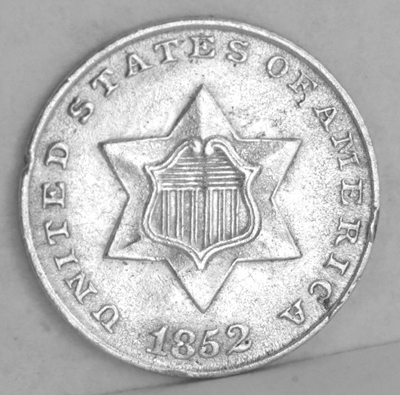 |
Even before the Civil War, shortages of small change had begin to appear and by 1851 it had been decided to produce a three-cent coin made of silver. Like the two-cent piece, its obverse was struck with a design rather than a portrait, to avoid confusion with another coin, this time the half dime, which was similar in size and composition. The front of the coin thus displays a six-pointed star and shield and the reverse was struck with the Roman numeral III surrounded by a large C for cents. Although the coin was originally alloyed with 25% copper, it was still very small due to the precious metal content, being only 14mm in diameter and weighing in at only 4/5 of a gram. Like the Eagle cent, the Three-Cent Piece was unpopular with the American people and despite an increase in silver content in 1854, it survived only until 1873. And in that last year, only proofs were made. | 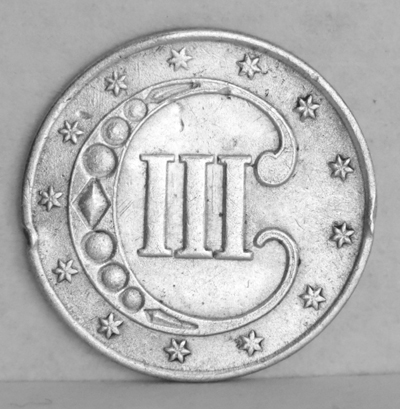 |
| This is one of only three of these types of coins that I own. I regret that two of them have the same date but that date did see a large number of them minted: 18,663,500. The coin above was not graded by the seller but I belive it to be an F 12. The coin is worth about $50 and is stored in the D case. | This coin was the smallest one ever produced by the U.S. mint and was often called a Trime. Examples are almost 4 mm smaller than the Roosevelt dime. | This is the reverse of the coin at left. The coin is extremely small and very thin due to the silver content which was intended to be representative of the value of the coin. This example is silver variety 1 which has no border around the edges of the star. |
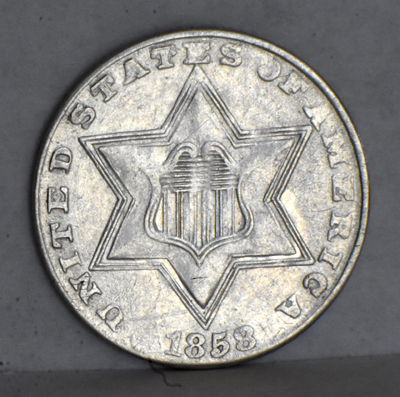 |
From 1854 through 1858 the star was made larger by the addition of two lines around its edges. Also the reverse was modified by adding an olive sprig over the III and three arrows below it. While this reverse design continued until 1873, one of the lines around the star on the obverse was removed in 1859. After 1862 the mintage of Trimes was very limited (less than 23,000 were made in any one year) and most of these were melted down in 1873. Survivors today are rare and valuable. |
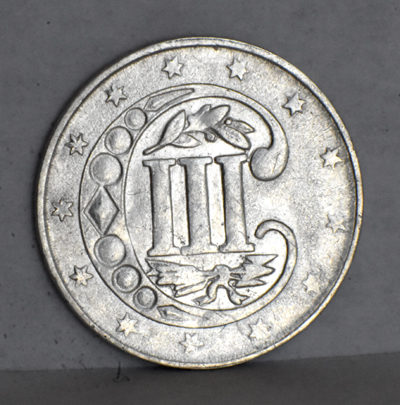 |
| This coin is 90% silver, cost me $250, and is graded AU 50 by ANACS. 1,603,700 of these were minted in Philadelphia. This example was removed from its slab and mounted in cardboard and stored in SDB 508. | In 1851 the New Orleans mint made 720,000 Trimes but none after that. | This is the reverse of the 3-cent piece at left. This coin is of silver variety 2. |
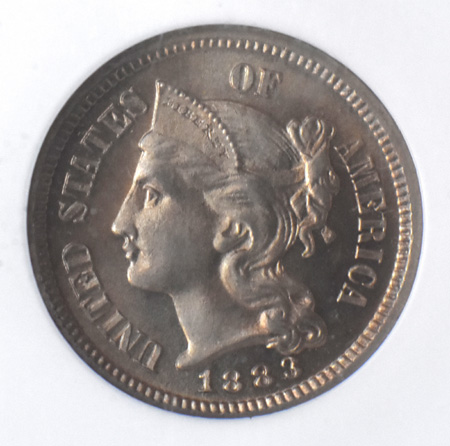 |
By 1863 the quantities of the three-cent piece being minted had fallen dramatically and in 1865 a new version of the coin was designed, although the previous issue continued to be made. The new coin no longer contained any silver, being composed of 3/4 copper and 1/4 nickel and although still valued at three cents, was popularly called a ‘nickel’. This coin was more popular than its predecessor and lasted for 25 years, eventually yielding to the lack of need for such a denomination. The obverse was struck with a portrait of Liberty and the reverse with the large Roman numeral III. This coin was 17mm in diameter. The 1877 issue is one of the rarest of U.S. coins; only 900 proofs were made. Each is worth more than $1000.
|
 |
| This coin is copper-nickel, and is graded as PF 65. Only 6,609 of this issue were made as proofs that year and it cost me a bundle. I now have an album that contains slots for the nickel three-cent pieces but this one is certified, slabbed, and is stored separately. | This is the reverse of the coin at left. | |
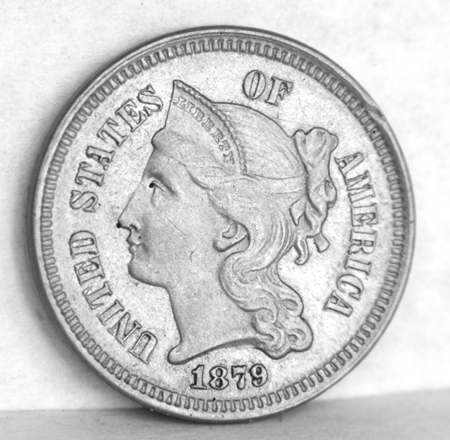 |
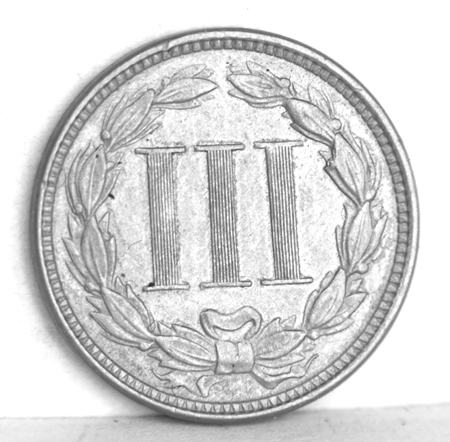 |
|
| The coin was sold as uncirculated and it does appear to be that. It is mounted in a plastic sleeve and stored along with (but separately from) the 2 cent, 3 cent, and 20 cent piece album. | This is the reverse of the coin at left.
|
|
 |
 |
|
| This one above is a recent addition to the collection but is certified as AU and therefore is stored in the D case. I bought it because it was the only one left in this set that am likely to be able to afford. It also is an example of a coin that was curculated, although briefly. Mintage of these was only 22,200. | I now have 18 of the 27 coins in this set, which includes 4 proof coins. | This is the reverse of the coin at left. |
| 1852: January 14: President Louis-Napoléon Bonaparte proclaims a new constitution for the French Second Republic. February 11: The first British public toilet for women opens in Bedford Street, London. March 2: The first American experimental steam fire engine is tested. March 17: Annibale De Gasparis discovers in Naples the asteroid Psyche from the north dome of the Astronomical Observatory of Capodimonte. March 18: Henry Wells and William Fargo created Wells Fargo & Company. March 20: Uncle Tom's Cabin, by Harriet Beecher Stowe, is published in book form in Boston. July 1: American statesman Henry Clay is the first to receive the honor of lying in state, in the United States Capitol rotunda. September 19: Annibale de Gasparis discovers the asteroid Massalia from the north dome of the Astronomical Observatory of Capodimonte in Naples. October 23: The conjecture of the four color theorem is first proposed, as student Francis Guthrie of University College in London presents the question of proving, mathematically, that no more than four colors are needed to give separate colors to bordering shapes on a map (the theorem is not proven for almost 123 years, until 1976). December 2: Napoleon III becomes Emperor of the French. Unknown: The Devil's Island penal colony opens in the colony of French Guiana. Smith & Wesson is founded as a firearms manufacturer in the United States. In Hawaii, sugar planters bring over the first Chinese laborers on 3 or 5 year contracts, giving them 3 dollars per month plus room and board for working a 12-hour day, 6 days a week. |
| 1882: January 2: The Standard Oil Trust, a monopoly, is secretly created to control multiple corporations set up by John D. Rockefeller and his associates. January 5: Charles J. Guiteau is found guilty of the assassination of President James A. Garfield, despite an insanity defense raised by his lawyer. March 18: Morgan Earp is assassinated by outlaws while playing billiards in Tombstone, Arizona. March 22: Polygamy is made a felony by the Edmunds Act passed by the United States Congress. April 3: Old West outlaw Jesse James is shot in the back of the head and killed by fellow outlaw Robert Ford in his home at St. Joseph, Missouri for reward. June 30: Charles J. Guiteau, the assassin of President James A. Garfield, is hanged. September 4: Thomas Edison starts the U.S.'s first commercial electrical power plant, lighting one square mile of lower Manhattan. November 14: Franklin Leslie shoots Billy Claiborne dead in the streets of Tombstone, Arizona. December 22: The first string of Christmas lights is created by Thomas Edison. |